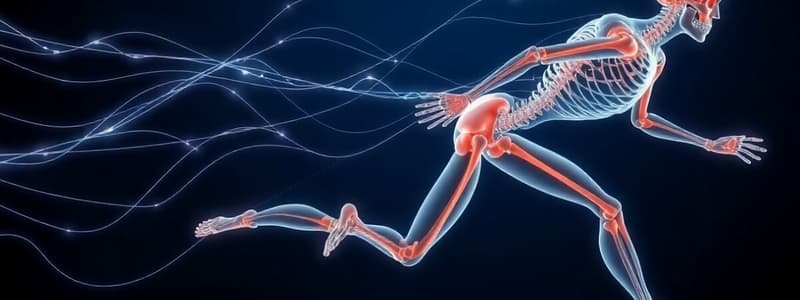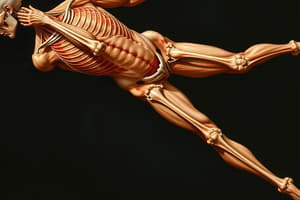Podcast
Questions and Answers
What type of force is transmitted from muscle to bone via tendons?
What type of force is transmitted from muscle to bone via tendons?
- Gravitational
- Tensile (correct)
- Frictional
- Compressive
Which of the following is NOT a factor influencing the mechanical advantage of a muscle?
Which of the following is NOT a factor influencing the mechanical advantage of a muscle?
- Type of muscle fibers (correct)
- Length of the muscle fibers
- Distance between the muscle force and the joint axis
- Angle of the muscle insertion
What is the term for the turning effect of a force around an axis?
What is the term for the turning effect of a force around an axis?
- Effort
- Moment (correct)
- Leverage
- Resistance
In a second-class lever, where is the resistance force located relative to the effort force and the axis?
In a second-class lever, where is the resistance force located relative to the effort force and the axis?
Which of the following is an example of a third-class lever in the human body?
Which of the following is an example of a third-class lever in the human body?
What is the primary function of the core muscles during occupational tasks?
What is the primary function of the core muscles during occupational tasks?
Which of the following accurately describes the arrangement of forces in a first-class lever?
Which of the following accurately describes the arrangement of forces in a first-class lever?
What is the primary function of levers in the human body?
What is the primary function of levers in the human body?
What characterizes a closed-chain movement?
What characterizes a closed-chain movement?
Which statement about tensile force is accurate?
Which statement about tensile force is accurate?
What effect does a longer moment arm have on muscle action?
What effect does a longer moment arm have on muscle action?
During which task is the lower limb typically in a closed-chain position?
During which task is the lower limb typically in a closed-chain position?
Which is an accurate description of resistance in the context of force?
Which is an accurate description of resistance in the context of force?
Flashcards
Open-chain movement
Open-chain movement
A movement pattern where a moving body part is free to move in space. For instance, swinging your arms to conduct an orchestra, brushing your teeth, or reaching for a glass of water.
Closed-chain movement
Closed-chain movement
A movement pattern where the body part closest to the ground is fixed, and the other joints move relative to it. Examples include squats, push-ups, and standing.
Force in biomechanics
Force in biomechanics
Any push or pull applied to an object or body part. In human movement, it can be either tensile (pulling) or compressive (pushing).
Moment arm
Moment arm
Signup and view all the flashcards
Exerted force
Exerted force
Signup and view all the flashcards
Force
Force
Signup and view all the flashcards
Resistance
Resistance
Signup and view all the flashcards
Effort
Effort
Signup and view all the flashcards
Moment/Torque
Moment/Torque
Signup and view all the flashcards
Muscle's Moment/Torque
Muscle's Moment/Torque
Signup and view all the flashcards
Levers in the Body
Levers in the Body
Signup and view all the flashcards
First-Class Lever
First-Class Lever
Signup and view all the flashcards
Second-Class Lever
Second-Class Lever
Signup and view all the flashcards
Study Notes
Kinetic Chains
- The cooperative, interdependent movement of the segments and joints of the body is referred to as a kinetic chain.
- Kinetic chain occurs in both closed-chain and open-chain movements.
Closed-Chain
- Proximal (distal) segments moving in relation to a fixed, nonmoving distal segment.
- For example, imagine squatting planted on the ground, creating closed kinetic chain.
- Pushing the body toward your hips and knees flex to lower extremities as the fixed position of the feet.
Open-Chain
- Moving the distal body segments in space, allowing joints to move together or independently.
- For example, the arm can move freely in space, independently from other parts of the body.
Principles of Physics
- Force, moment, levers—all concepts, from physics.
- Essential when considering the musculoskeletal systems acting internally or externally.
Force
- Any push or pull of matter.
- In humans, force occurs in the form of tensile force (pulling) or compressive force (pushing).
- Tensile force occurs between anatomical structures in the body.
- Compressive force occurs between muscle tissue and bone.
- Motor performance skills (e.g., reaching, lifting, and transporting) involve external resistance.
- Resistance must be overcome by effort.
- The internal force needed to overcome resistance is referred to as exerted force.
Moment
- The moment (action) of a muscle is affected by the distance between the muscle and the joint.
- The farther the muscle is from the rotational axis (joint), the greater the mechanical advantage.
Levers
- Levers or pulley systems are functional mechanisms in the body.
- Classified by the arrangement of effort (muscle) and resistance.
- First-class lever—exerting force and resistance on opposite sides of the axis. Example: cervical spine.
- Second-class lever—resistance being closer to the axis. Example: ankle.
- Third-class lever—effort being closer to the axis. Example: elbow.
Studying That Suits You
Use AI to generate personalized quizzes and flashcards to suit your learning preferences.




